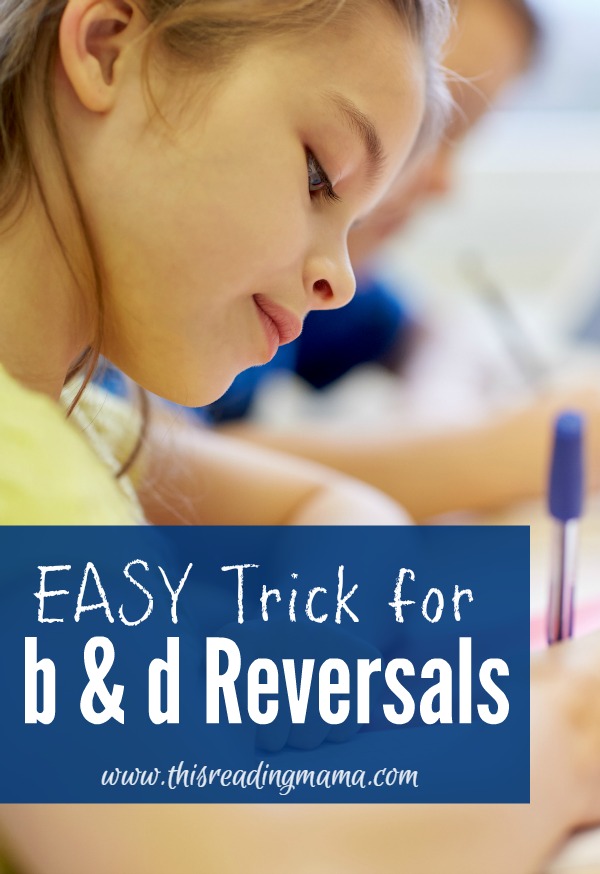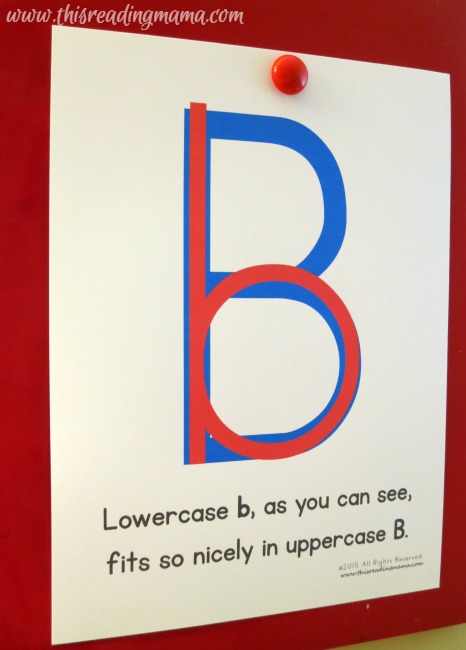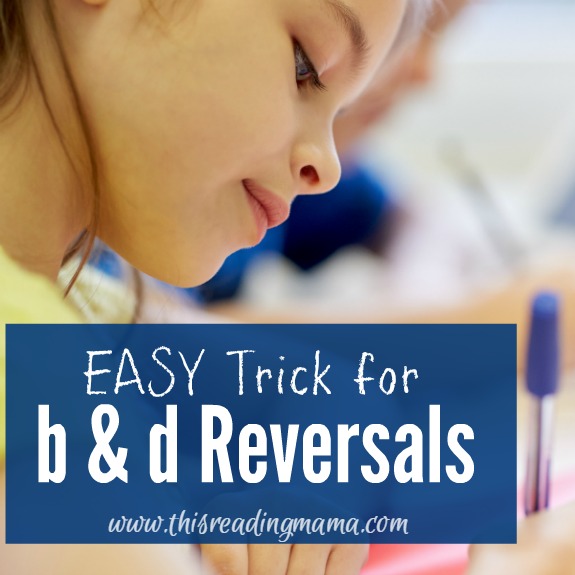B and D reversals are a common issue among younger children. There are many “tricks” teachers and parents try, like holding your fingers up to form the b and d or that the b has a belly and the d doesn’t. But in my experience, these tricks don’t always “do the trick” because kids still have a hard time visualizing which way the b and d face.

*This post contains affiliate links.
B and D Confusion from a Developmental Approach
Older, struggling readers/writers can also confuse b and d. Just recently, I had an interesting discussion with a homeschooling mom and it reminded me of the importance of thinking about these confusions from a developmental standpoint. Our discussion went something like:
“I have a 3rd grader and she still reverses her b‘s and d‘s. My friend has a daughter in the 3rd grade who doesn’t do this and she told me that my child shouldn’t be doing this anymore either. Should I be concerned?” This was a question a mom recently asked me. And I thought it was a good one at that!
I probed further to find out that her child was reading and writing on a 1st grade level. Developmentally speaking, this student was a 1st grader, despite what literal “grade” she was actually in.
I responded something like, “Your daughter is demonstrating the spelling behavior of a 1st grader because that’s the developmental stage she’s in. Students in this stage still do reverse their letters on occasion, so for her developmental stage, she is ‘normal’.” Does that mean the mom should not be concerned? No. But that’s a post for another day.
Today, I just want to drive home the point that, we need to remember to look at the whole child as we observe and assess. Instead of expecting literacy behaviors based solely off of a student’s grade level, we need to make sure we take into account what developmental stage she is in.
Easy and Discreet Trick for B and D Reversals
As for the b and d reversals, it can be a source of embarrassment for kids who are the older grades, yet in a younger/lower developmental stage. Here’s an easy-peasy trick that I’ve used with students I’ve tutored. With a pencil, lightly write a capital B at the top of your page. The lower case b will fit inside of it. When you’re done with your writing, erase your B and no one will ever know that you needed it. 🙂

And just in case you’d like one to put up for your child who’s writing at home or for your students at school, I’m including a FREE printable poster pack! You can download it HERE.
More Help for Teaching Struggling Students:
- 10 Things Struggling Readers Need
- Reading Comprehension Strategies {Fix Up Strategies}
- What to Say When a Child Doesn’t Know a Word
- 4 Things to Consider When Picking Books for Struggling Readers
- How to Plan for a Reluctant Reader
Follow This Reading Mama’s board Struggling Readers on Pinterest.

I have never used your idea for b! I love it! I always used the word bed to teach my students, I would show them how the word can be turned into a real bed…. but now I can show both!
Love the tip!
Yes, I used the word bed when I taught K-1 and had it posted in my classroom for kids to refer to. There’s also another one where the kids make the b and d with their hands and that’s supposed to help, too. But the lower case b within the capital B is more discrete and with older kids, that’s important. One tutee in particular had complained that her classmates were making fun of her for using her hands to make the b and d; which absolutely broke my heart!
I didn’t think to use the capital B trick either. Thanks for sharing this! If a child writes in manuscript or D’Nealian style writing it helps prevent reversals in writing. I can usually get a reader to write the letter they are trying to read in the air to decide if it’s a b or d.
Too bad kids have to make fun of each other. Your trick is great.
Love your blog!
Thank you! Just saw a link from Pinterest to this. I am going to try this TOMORROW with my new 2nd graders, who are reading at a K/1st grade level. They are both delayed in areas due to their early beginnings (adopted internationally at 3 and 5). We are starting a tutorial and I’ve worried about the b/d mix-up. This is a great suggestion for discreetness! Love it! Going to pin this to my reading board as well!
Oh, I’m so glad you’re going to try it. The older students I taught loved it and it seemed to really help if they used it consistently. Thanks for taking time to stop by and pin.
Still struggling with this little guy I am helping- tried all of the above even the b on left hand d on right hand – make an okay sign and pull the three fingers together on left you have the b on right you have the d. This poor little one, grade 3 is still confused. Any other ideas???????
Did you already try the capital B and lowercase b that I mention in the post?
Thank you so much. I am an EC teacher and my kids all struggle with this. I have tried different ideas but this is such a great way to help them.
I always use this: when you look at the letter b, the first thing you see is a line. When you say the letter b, your mouth makes also a line.
But, I’m also going to use your trick, every child learns different.
Thanks for that tip too!! Hoping all these combined will help mine sort it out. 🙂
I have a hand trick that has worked really well with my fourth graders who have a hard time with this persistent reversal. Hold up your left hand. Point your index finger up and connect your middle finger and thumb to make the letter b. Next to that, make the letter d in a similar fashion with your right hand. Say “bed” , physically emphasizing the “b” and “d” as you pronounce them. The upright pointer fingers make the headboard and footboard of the bed from a side view. Imagine someone sleeping on the mattress, formed by the round parts of the letters. Hope this helps, too!
Those are great tricks, too. For my older, struggling readers those weren’t discrete enough. One told me outright, “The people in my class make fun of me when I hold my hands up to make the b and d.” It broke my heart.
I have recently started homeschooling and the curriculum that I am using had a great way to read or write the “b” and “d”. The “b” is a bat(the long straight line first) and a ball (followed by the round part). You have to have the bat first to hit the ball. The “d” is a doorknob (you have to turn the doorknob first to open) and a door. My daughter loves using this code to decipher what she needs to know to decipher a word!
I’ve been teaching first grade for 16 years now and tried ALL of the above including the whole “bed” thing (with poster and hand/finger models), bat before ball/doorknob before door, and drawing on the board the lower case and upper case B’s on top of each other. I really love the colored poster with the B’s; I think the visual will really help. I’m going to put 2 or 3 around the room (so all can see) and we will see! Thanks so much for sharing your posters for free! It is developmental and in many cases will resolve on it’s own but I am all for helping that process along!
I tried all those tricks, too, but it seemed that kids would think deb in their head instead of bed if they didn’t have the poster and still get it wrong. The nice thing about the capital B is that most kids know what it looks like, with or without the poster, making it a little easier to remember. So glad you can use it!
Thanks for sharing this two stories Terry.
My first graders love stories that teach.
I’ve tried all the rest of the suggestions. Now I’ll have to try the capital B. What a great suggestion!
Thank You.
I’d love to hear how it goes! 🙂
I had trouble with this when I was a kid. My solution was to look at the word Dad, which is usually spelled with an uppercase and lowercase letter d. In my head I would tell myself that Dads love hugs. And in order to hug you have to face each other. So I would visualize the big d and made the little d facing so they could hug. After that memory trick I never had a problem again.
What a great way to visualize those letters! Love your trick! 🙂
Do you have any ideas about why a child going into 2nd grade would still be making reversals (not just b and d), but is above grade level in reading and writing?
I’d need to do some thinking on that one, Jill.
I’ve been teaching dyslexic children for 23 years, and I’ve learned that they never grow out of the b/d reversal problem. However, when they get older they have learned survival skills to help them remember which is the “b” and vise versa. I had a seventh grade student that constantly used the “b” trick by making a “b” with her left fist and thumb straight up to visualize the “b”, and she knew that the other fist made the “d”. That helped her tremendously. If children are still having trouble with this after kindergarten, I strongly feel as though they are possibly dyslexic.
I remind students that to make a stick person you draw a vertical line first. So, I draw vertical line down as I say “a b, b, boy”, and as I finish the b I continue by saying “with the big belly”. Then I tell them because he ate a b, b, basketball. To make a d, you don’t make a “boy” first because you start in the middle of the letter. Haven’t fine-tuned this idea but off the top of my head, it came out one day and I’ve been using it sense. Works for some. 🙂
since. 🙂
Cute! It’s great when you find something that works.
Thank you I love the idea! I have used the the bat and baseball idea but this is a more concrete concept for the child learning the difference. I also took notes from your “Reading Strategies for Unknown Words”. Encouraging the reader to think by asking those type of questions, really puts the focus on learning to read and not just sounding out letters. Thanks again
Thanks for this post! Very clever. I’m going to try with my daughter.
Thank you!
love this idea! I have a high reader but noticed his spelling/writing is low (2nd grader). He reverses his b, d and also the number 5. Any suggestions for the number?
I’d have to think on that one. I guess my only suggestion would be to keep a resource available that shows the correct way to form the 5 when you can, like this one–> https://thisreadingmama.com/printable-number-chart-1-20/
Thanks for all your tips. The thing that finally worked for my son was to point out that when you say the sound /b/ your mouth makes a line so the line goes first, with /d/ your mouth makes a circle so the circle goes first. Same with /p/ and /qu/ .
What a cool trick!
My daughter is five and in the process of learning to read. She’s in Pre-K and knows a good number of sight words. We’re currently working on phonemic awareness and phonics and the b / d reversals keep popping up. I understand, developmentally, that this problem shouldn’t concern me until she hits 1st grade. However, I want to help her now so she can be successful in Kindergarten this Fall. I like the small “b” fits in the large “B”. It’s a nice visual. Any other tips for an emergent reader who hasn’t hit Kindergarten yet? I feel some of the aforementioned finger examples, although great ideas, would be too abstract for her to understand.
Yes, I have also these –> https://thisreadingmama.com/letter-reversals-handwriting-pages/ and these–> https://thisreadingmama.com/letter-reversal-posters/
I’m really curious about the “that’s a discussion for another day.” I have a 2nd grade girl going into 3rd in a few months (we homeschool) and she is still basically in 1st grade when it comes to reading. We are making progress and it’s clicking and she is doing SO much better but I don’t feel that she is fully any of the learning disabilities. It’s like she has 1 or 2 points but never enough to be full blown dislexic or sensory or any of the others. I am worried but only in the “we need to figure this out” kind of way. I know that she is learning and making progress, it just took her a little longer for it to start clicking. But, I would love to hear more about “should she not be worried, well no, but that’s a discussion for another day.”
And we have tried using the honey-b and c-d trick where you start writing an h and say honey bee and loop the h into a b and with d you write the letter c and then say d since it is the next letter in the alphabet and write the veritcal line against the c to make a d. But, I’m loving the hide the b inside the B!
This has just been my experience. I cannot advise you on what you need to do for your daughter.
I had my oldest son evaluated at grade 3 because there were several things not clicking for him. But this evaluation was required to get him into a private school specifically for children with learning differences. If I had planned on homeschooling him, I may not have had the evaluation done because it mostly told me things I already knew about him from working with him at home. The strategies and interventions she suggested I try were things I was already doing (or trying to do) with him.
But that’s just my experience. If you feel you need strategies and interventions for her, I’d suggest having her evaluated. It’s not so much about the label, but making sure your child is getting what she needs. Your pediatrician should be able to refer you to someone.
Hope that helps!
If she is left eye dominant may be struggling more because of this in reading. She may be working extra hard to track left to right because her eyes and brain naturally are tracking right to left. Happy to give additional info on I am an OT and see this often. At times also see hard time with visual tracking skills and / or crossing midline which impacts reading so much
Do you have any other letter reversal trick posters like the one you have about b sitting nicely inside B? They are very helpful.
Yes, I do! I have these posts (with freebies):
https://thisreadingmama.com/letter-reversal-posters/
https://thisreadingmama.com/letter-reversals-handwriting-pages/
https://thisreadingmama.com/letter-reversal-worksheets/
Hope that helps!
~Becky
Do you have any information on helping kids with sight words? I am doing some tutoring at our neighboring school and have a little boy in 1st grade who seems easily confused by similar looking words such as were and where. I would appreciate any information you could give me.
Thank you.
I have TONS of printable resources and articles here. The one that pops into my mind is this one: https://thisreadingmama.com/sight-words-when-they-just-dont-stick/ But feel free to search “sight words” in my search bar to find more that you think will help. 🙂
I have a 6yo. He’s having D/B letterwriting issues. So I stooped to his level so it would be easier (and sillier) to learn and remember. I told him lowercase Bs and Ds are just Ls with either a belly or a butt. b……d…. He got a kick out of it.
That’s funny!
I cant wait to implement this in my classroom. This is a great article
My child is in FIFTH grade and still reverses (maybe half the time). I’m tearing my hair out. I’ve done all suggestions–tried the lowercase b inside uppercase B long ago, as well as the “bed” trick and the “ok” hand signs. I’ve also had her write “b” over and over on a piece of paper. It’s just not sticking.
Hi Bea, are you allowing her to keep the visuals with her to help them stick? My fourth grader still reverses hers often, but does so less often if she has the visual right there to refer to. {I fixed my misspelling, too!}
I love this visual, it will definitely add to the trick I always use. I tell my beginning readers that b has a bump so it bumps into the next letter. This poster makes that so much more clear. d has a donut and it comes before the line because we always want to eat the donut first! That also helps them write it correctly where the trick is to make the line first or the c first.